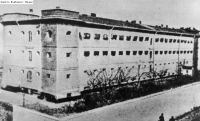 |
| Pawiak Prison |
A decision to erect a new prison in
Warsaw was taken in
1829.
This prison, later called "Pawiak", was located between
Dzielna, Pawia,
and Wiezienna Streets. The construction works started in
1830
and were completed in
1836. The buildings were designed by
Henryk Marconi, official builder and one of the most outstanding Polish architects
of the 19th century. The first inmates were imprisoned in
1835.
The prison had a rectangular shaped plot occupying an area of 1.5 hectares, surrounded by a wall with two turrets
on the
Dzielna and Pawia Street sides. The main building which contained the
men’s section, consisted of four storeys. The women’s prison,
known as "Serbia", had three storeys. The complex also included various auxiliary buildings, such as warehouses,
workshops, a kitchen, storerooms, baths, a boiler house, potato treatment rooms, and a laundry.
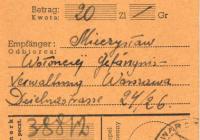 |
| Money Order from 1940 |
During the first period under German occupation, until
March 1940, the prison
was subordinated to the Department for Justice of the
Generalgouvernement. From that date Pawiak
became a prison under the office of the Commander of Security Police, SD, and
Gestapo.
At the beginning of
November 1940, permanent German staff took up duties in the prison.
This affected the conditions within the prison,
as Polish warders had tried to help the inmates in various ways, including permitting contact with the outside world.
The Polish warders were arrested in
March-April 1942. Pawiak, designed to accommodate
1,000 inmates, housed three times that number. The conditions in the prison were harsh:
"
Although a small grated window was open at all times, the air inside the cell was unbearably stuffy
– a nasty chill in winter and an equally nagging heat during the summer months. Despite frequent delousing –
bedbugs and fleas made inmates’ lives miserable."
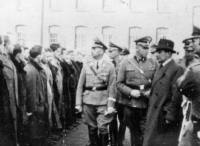 |
| Himmler Visit on 17 April 1942 * |
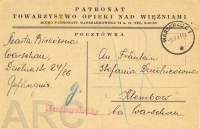 |
| Postcard from 1941 |
Food at Pawiak was insufficient throughout the entire period of the German occupation. The worst situation was in the
second half of 1941, and during the whole of
1942.
Without aid the prisoners could hardly have stayed alive.
The first public execution in
Warsaw was closely linked with Pawiak.
The announcement of
3 November 1939
informed the populace about the execution of Ms.
Eugenia Wlodarz and Ms.
Elzbieta Zahorska
who were arrested for tearing down a German propaganda poster reading "England this is your work". They were
imprisoned at Pawiak and later executed at
Fort Mokotowski.
 |
| Postcard from 1942 |
Around 250 Pawiak prisoners were executed from
1939–1944 in
Warsaw and its surrounding areas:
Bukowiec,
Palmiry, Wolka Weglowa, Luze, Laski, Magdalenka, Stefanow, Las Kabacki, Waver, and Anin.
The executions reached their climax in
1943 and 1944. From
May 1943, after the
Warsaw Ghetto had been
crushed and the ghetto turned into ruins, executions were carried out in the streets near the prison, such
as
Dzielna, Gesia, Zamenhoffa, and Nowolipki Streets.
Pawiak became a symbol of the harsh occupation and inscriptions reading "
Pawiak Pomscimy" ("Pawiak shall
be avenged") appeared on walls, notice boards, and even on the pavements. The prisoner’s most vivid memories are of the
interrogations at the
Gestapo Headquarters at
Aleja Szucha (Straße
der Polizei), where many prisoners were tortured to death.
Leon Wanat, a prison office worker:
"
Twice a day, at noon and in the evening, the motor car brought back the same prisoners to
Pawiak in poor condition. One was under the impression that this was an ambulance carrying victims of an accident.
Their faces were pale with blood-stained, black-ringed eyes, clothes crumpled and stained or torn – without sleeves and
with the pockets torn off. Some of them slid down slowly from the vehicle – supported by their companions in distress.
Their mere appearance told much about the interrogation methods used by the Gestapo."
Around 60,000 inmates from Pawiak were deported to concentration camps. The first transport left the prison on
2 May 1940 for
KZ Sachsenhausen, but most went to
KZ
Auschwitz-Birkenau. 53 transports of men, and 11 of women were sent there
from 14 August 1940 until 12 / 13 August 1944.
As they were driven in a prison van from
Aleja Szucha after brutal interrogation,
on
26 March 1943, as a result of co-operation between a clandestine network inside the
prison and the Polish underground, special storm troops of the Grey Ranks rescued
Jan Bytnar Rudy, commander of the Grey Ranks of southern
Warsaw near
Arsenal,
at the intersection of
Bielanska and Dluga Streets, together with 25 other prisoners.
"
During the Ghetto Uprising in April–May 1943
Pawiak became an assault base for the Nazis. Jailers from Pawiak, under the command of
Burkl, volunteered to hunt for the insurgents. Captured victims were beaten,
humiliated and ill-treated. Then they were shot dead at point blank range in the back of their head. Men and women alike.
Also the Ukrainians did the
same. Later, like their masters, they returned excited by murder. We looked at their faces with disgust –
we were petrified to hear their tales. In Pawiak cells were filled with acrid smoke. We could smell human
bodies burning. Iron cupboards and beds were scorching. Rubber soles turned
into balloons. Apparently, we would also go up in flames."
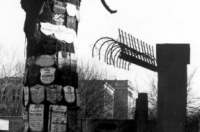 |
| The Memorial in 1986 |
 |
| The Memorial in 2005 |
After the final ghetto liquidation in
May 1943, the Jews caught in the "Aryan Quarter"
of the city, were brought to Pawiak, marked with a plus
sign and immediately placed in dark, dirty, bed-bug infested cells in Section VIII. Executions were
carried out nearly every day. The Directorate of the Civilian Struggle, with co-operation of the clandestine
prison unit and the Polish Home Army, pronounced death sentences on
Gestapo men from Pawiak and
Aleja Szucha.
Hans Burkl, deputy commander of Pawiak, a sadist and multiple murderer,
was shot dead on
7 September 1943 by soldiers from the Agat detachment at the corner of
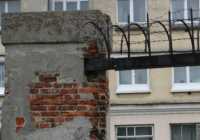 |
| Remnants of the Gate |
Marszalkowska and Litewska Streets.
In
1943 and 1944, soldiers of the Home Army executed other members from Pawiak and
Aleja Szucha:
SS-Oberscharführer
Herbert Schultz (
6 May 1943),
SS-Rottenführer Ewald Lange (
22 May
1943),
SS-Rottenführer Ernst Wefels, the jailer from Serbia
(
1 October 1943),
SS-Obersturmführer Jacob
Lechner (
5 October 1943), and
SS-Scharführer
Stephan Klein (
25 October 1943).
Some other German and Ukrainian SS members who served at Pawiak:
SS-Unterscharführer Otto Wulfes,
SS-Rottenführer
Albert Müller,
SS-Rottenführer Thomas Wippenbeck (also known as "the hangman"),
SS-Oberscharführer and Deputy Commandant from
1940 - 1941
Hans Felhaber,
SS-Rottenführer Arno
Schubert,
SS-Oberscharführer Engelberth Frühwirth, and
the Ukrainian SS man
Michael Kowalenko.
Following the last group executions on
13 and 18 August 1944,
German sappers blew up the prison on
21 August 1944.
Today a few remnants of the prison complex are included in the memorial.
Photo: GFH
*
Source:
Pawiak 1835 - 1944 – The Guidebook Muzeum Niepodleglosci, Warszawa 2002
© ARC (http://www.deathcamps.org) 2006















